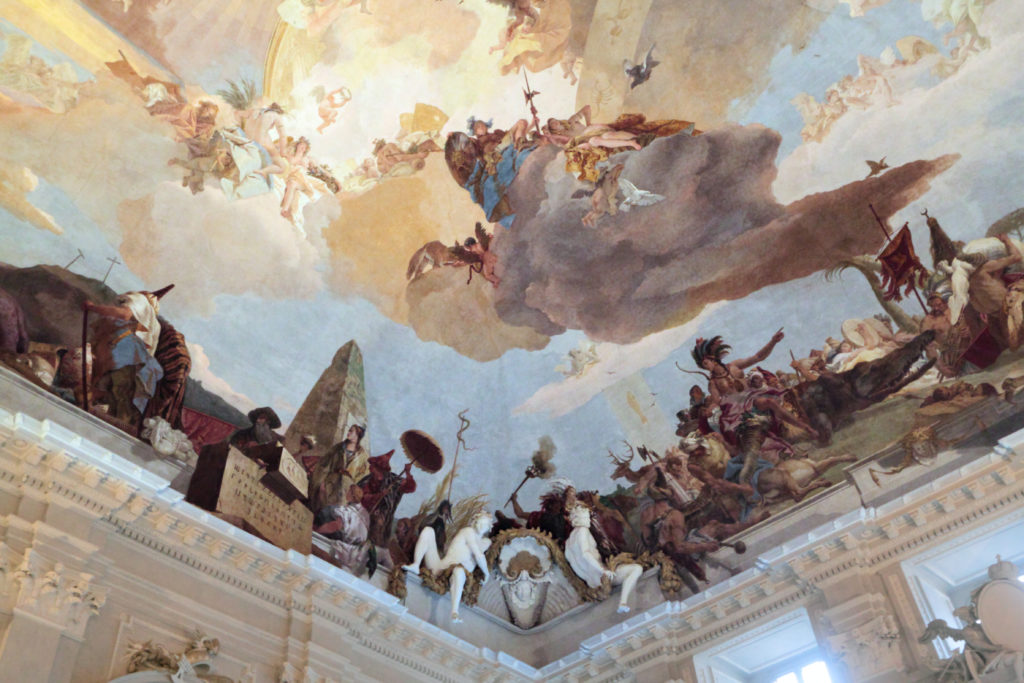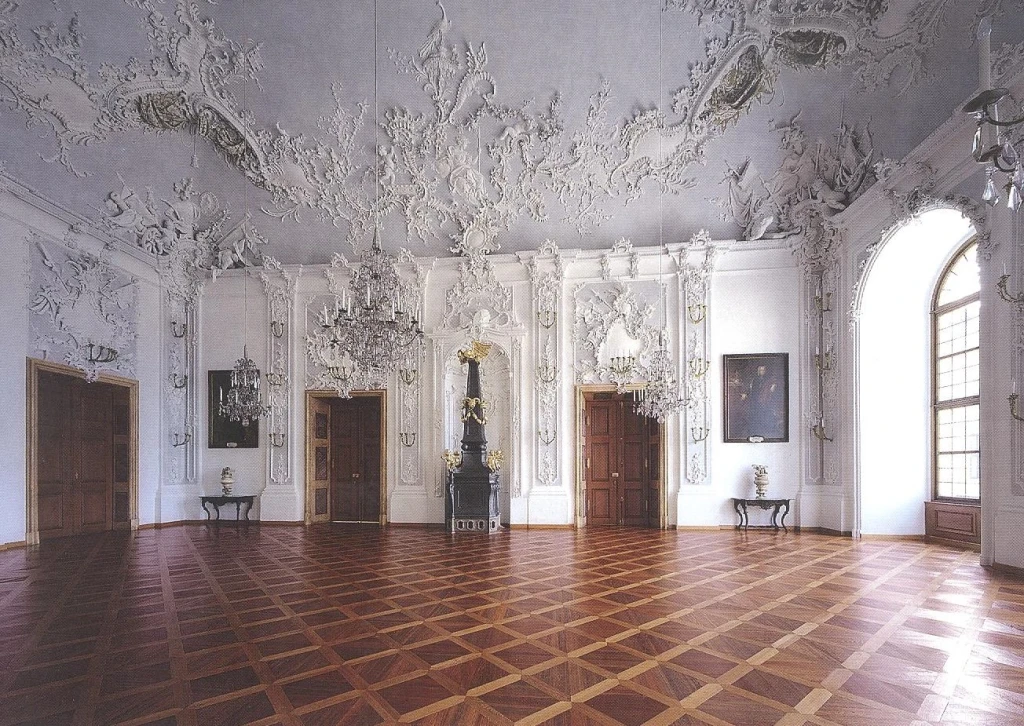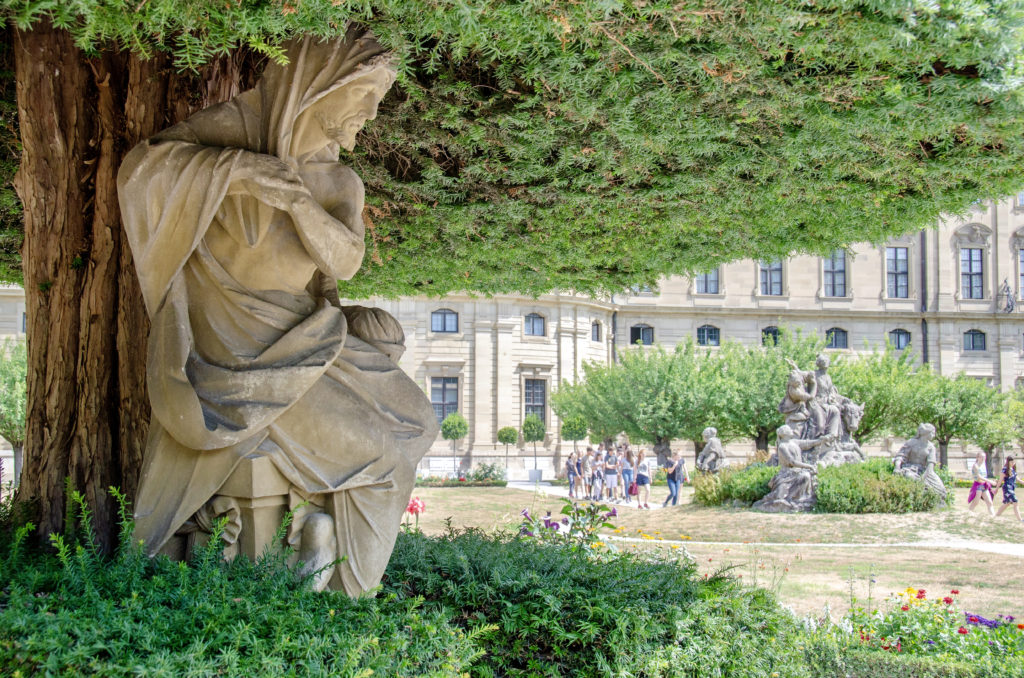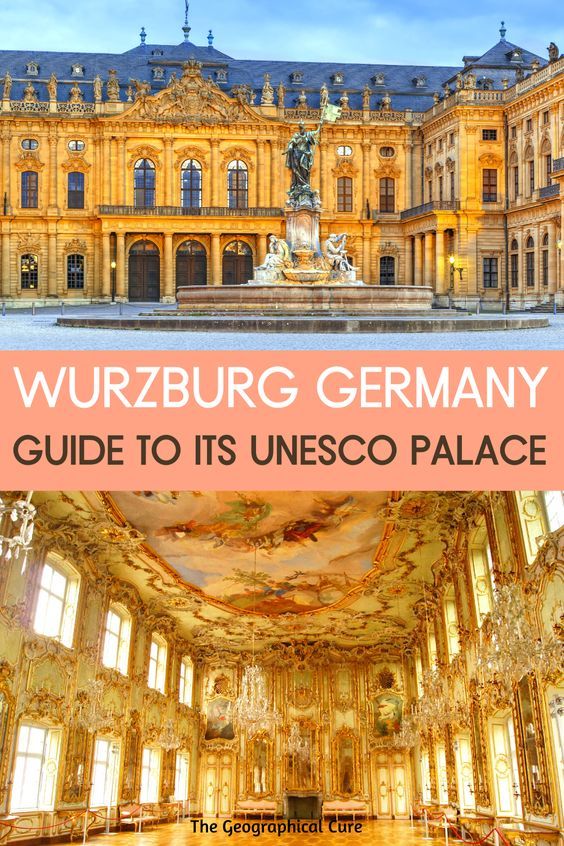The Würzburg Residence is a must see UNESCO World Heritage Site where you’ll step into a world of opulence and history. With resplendent interiors, lush gardens, and a rich cultural legacy, is one of Europe’s most important Baroque palaces.
Wurzburg is a small town in northern Bavaria. But there’s nothing “small town” about its vast palace. It’s swishy and luxurious.
The palace is so glamorous that it’s been dubbed the “German Versailles.” And it’s a much more enjoyable experience than its nick-namesake, the French Versailles.
Compared to Louis XIV’s over-touristed digs, the Wurzburg Residence was blissfully uncrowded on a nice October day.
The Wurzburg Residence is the former home of the Wurzburg bishop-princes, the elected rulers of the Holy Roman Empire.
It’s the first stop on a tour of the Romantic Road in Bavaria. These princes had both secular and religious authority.
In 1720, prince-bishop Johann Philipp Franz von Schönborn commissioned the residence. He aimed to create an eye popping spectacle, something akin to the grandeur of Versailles. And he succeeded.
READ: Guide To 25 Stunning Palaces in Europe
The lead architect for the project was Balthasar Neumann, a relatively newbie and unknown figure at the time. To my mind, his architectural design is lovely, an elegant blend of French chateaux meets Viennese Baroque.
The palace took 60 years to build. The highlight is the intricate stucco work and the magnificent frescos by Giovanni Battista Tiepolo, a famed Italian Rococo artist.
I was lucky to arrive just when a English tour was starting. The tour lasts about 45 minutes and you have access to 40 of the 400 rooms.
You can also explore the Northern Imperial Apartments on your own, but there’s almost no signage in English. The Southern Imperial Apartments can only be visited on a guided tour
Like many of Germany’s grand buildings, the Wurzburg Residence was left in ruins after a WWII air raid on March 16, 1945. The worst damage was caused not by the bombs but by the subsequent fire. The fire ravaged the wooden-roofed structure, leaving it essentially a shell.
The Germans weren’t content to allow their fantastical creation to lie in ruins. So it was rebuilt over 40 years to the tune of 20 million euros. But you’d never known it wasn’t original, it’s so well done.
Let’s peak inside, with this guide to the Wurzburg residence.
Guide To The Wurzburg Residenz: What To See
Here are the things you will see at the Wurzburg Residence.
1. Grand Staircase and Tiepolo Fresco
You begin at the Vestibule. The Vestibule was where fancy guests swept in by carriage and were dropped off for their palace visit to make their movie-star entrances.
The story goes that, when Napoleon became Emperor, his carriage was too big to fit through the gateway. But Napoleon liked the palace. He called it, both nicely and ironically, the “nicest parsonage in Europe.”
Take Neumann’s Treppenhaus, or the grand staircase, and float upstairs toward the White Hall. The ladies sometimes took 30-45 minutes to negotiate the stairway and be seen in their splendid ballgowns.
At the top of the zigzagging staircase, the magnificent Tiepolo fresco opens up before you. At 18 x 30 meters, it’s one of the larges frescos ever created — larger than Michelangelo’s frescos in the Sistine Chapel.
Tiepolo was a famous Venetian Rococo painter and master of illusion. 3D figures jump out at you around the edges, like sculptures extending from a 2D canvas.
At first, Tiepolo was reluctant to agree to the commission. He couldn’t be bothered to travel from Italy. He only agreed to the project after he was told he could have the entire ceiling. Ultimately, he just couldn’t resist the magnificent space.
The Tiepolo fresco mercifully survived WWII, despite the ravaging fire. It was protected by the stone ceiling.
The frescoed ceiling depicts stories from the then-known four continents — Africa, Asia, America, and Europe. America appears desperately uncivilized. Europe is depicted as the height of culture, with architect Neumann in the center. Asian and Africa are on elephants and camels, respectively.

At the time, critics attacked the boy-architect Neumann. The disbelievers claimed the building couldn’t support the weight of the stone ceiling.
Neumann protested that the ceiling would hold “even if a canon was fired on it.” He was ultimately proven correct.
2. The White Hall
After admiring Tiepolo’s vast fresco, you enter the White Hall or Imperial Hall. Prepare to be amazed.
With its white stucco and white chandeliers, it practically shimmers. Some of the stucco looks like actual curtains or fabric. It’s one of the world’s most beautiful ballrooms.

The White Hall has a marble floor and there’s gold everywhere. The columns are made of “stucco marble.”
It’s a material that allows the columns to look like they’re created from one block of marble. “Stucco marble” is even more expensive than regular marble.
The White Hall also boasts frescos by Tiepolo, including depictions of the marriage of the emperor and the emperor crowning a Wurzburg bishop as prince.
There’s also a 3D dog at the bottom of one fresco. It mysteriously appears to change size as you walk around the room, one of Tiepolo’s optical illusions.
Then, you head into the older southern part of the palace to see the Imperial Apartments. You proceed through a series of doors, which magically create another optical illusion. Each succeeding door seems smaller, even though it’s not.
3. The Audience Room
The Audience Room is the gilded room for the emperor to meet visiting dignitaries. Along with the Antechamber, it’s filled with 17th and 18th century tapestries that were hidden in wine cellars during WWII.
One interesting factoid is that there were small hidden niches in the fireplace mantle. These niches were used to pump out fragrances into the air to disguise the smell of all the luminaries.
People at this time were scared of water and didn’t bathe, a frightening state of affairs.
4. The Ceremonial Bedroom or Venetian Room
The Ceremonial Bedroom is also called the Venetian Room. Its tapestries depict the Venetian Carnival.
You can tell it’s a bedroom because the ceiling frescos show the passing of time from sunrise until nighttime.
There was no bed in the bedroom though. On purpose. If you were a guest and wanted to make use of the bedroom, you had to bring your own bed.
5. The Mirror Cabinet
Next, you enter the gaudy, over the top Mirror Cabinet. What distinguishes this room from other hall of mirrors is that the 600 mirrors are painted from behind and etched in gold leaf.
The delicious Mirror Cabinet was destroyed during bombing in 1945. When craftsman began work on the restoration, they had to essentially re-learn an old trade to recreate the effect.
The room has a gorgeous Murano glass chandelier. The bishop-prince spied the chandelier in Venice. To solve the issue of possible breakage during shipping, he had the chandelier encased in butter that hardened around it, protecting it.
This led to a still used German expression. If something is “all in butter,” that means everything is just great.
6. Northern Apartments
Originally decorated beginning in 1742, these rooms can be visited without a guide. They’re also in Rococo style, but perhaps less ornate than the Southern Apartments.
The ceilings are white and gold, but without the elaborate paintings. The Northern Apartments were supposed to have a grand cabinet as well. But it was never built.
7. The Court Chapel
You access the Court Chapel, known as the Hofkirche, through a separate entrance in the interior courtyard.
The Baroque and Rococco chapel was completed in 1743 under prince-bishop Schönborn. It was designed by renowned architect Balthasar Neumann and built between 1743 and 1744.
It’s another Neumann and Tiepolo co-production. It’s small, but richly decorated with sculptures, frescos and variegated marble columns.
The chapel features a stunning elliptical dome with a painted ceiling that depicts scenes from the Old Testament. Tiepolo’s artwork on the dome is considered one of his masterpieces.
8. Wurzburg Residence Gardens
Don’t miss a stroll through the palace gardens, the Hofgarten, which you enter via frilly iron gates. The gardens were designed in the mid 18th century by garden designer Johann Prokop Mayerare.
The Court Gardens are designed in a terraced style, which was a typical feature of Baroque gardens.
They’re decorated with sculptures, including fanciful ones of children. The gardens are symmetrical, but not in an overly rigid French way.
Wurzburg is an easy day trip from Nuremberg, another fantastic Bavarian city And if you’re on the UNESCO trail, the Wurzburg Residence is a must see site in Bavaria.
Practical Guide & Tips For The Wurzburg Residence
Here’s what you need to know about visiting the Wurzburg Residence:
Address: Residenzplatz 2, 97070 Würzburg, German
Hours: April-October: daily 9:00 am to 6:00 pm (last entry: 5:30 pm), November-March: daily 10:00 am to 4:30 pm (last entry: 4:00 pm). Gardens open until dusk or 8:00 pm at the latest
Entry fee: 9 euros. A guided tour is included in the admission fee. The gardens and chapel are free to visit.
Pro tip: You’ll have to check your backpack. There’s a cafe onsite. Take the guided tour because there’s not much signage. Save some time to see parts of the Residence not covered on the tour and the gardens.

Tours: Guided tours in English are at 11:00 am and 3:00 pm. They are included in the admission price.
I hop you’ve enjoyed my guide to the Wurzburg Residence. You may enjoy these other Germany travel guides and resources:
- 10 Days in Bavaria Germany
- Guide To Germany’s Romantic Road
- 1 Day In Munich Itinerary
- 4 Days in Munich Itinerary
- Guide To Neuschwanstein Castle
- Prettiest Towns in Germany
- Tips For Visiting Germany
- Guide To Rothenburg ob der Tauber
- Guide To Fairytale Castles in Bavaria
- Guide To Regensburg
If you’d like to visit the Wurzburg Residence, pin it for later.

